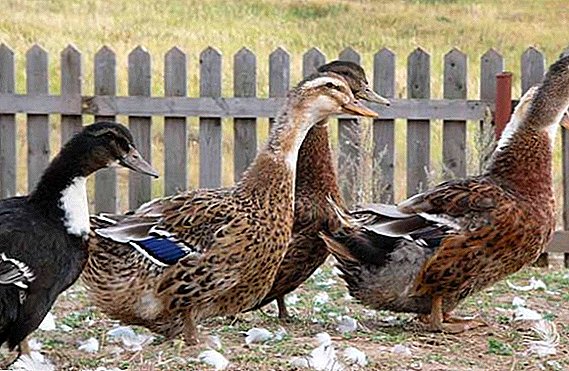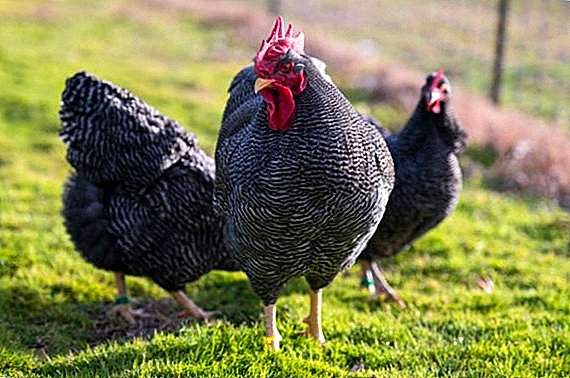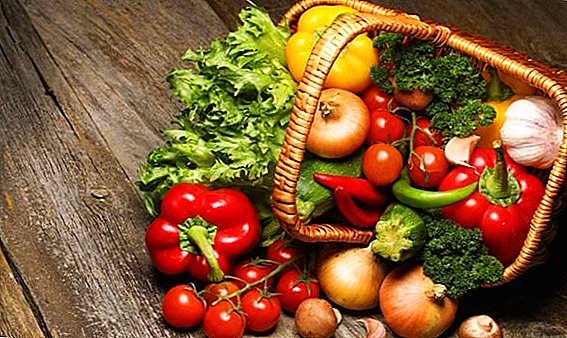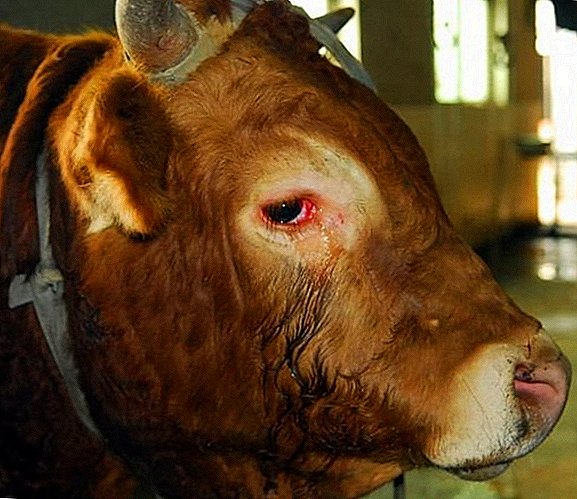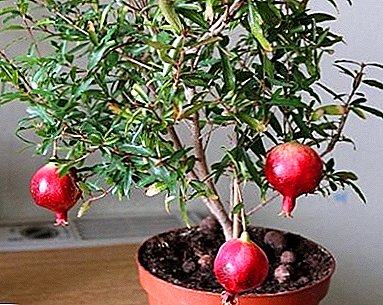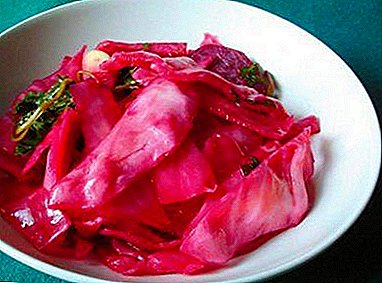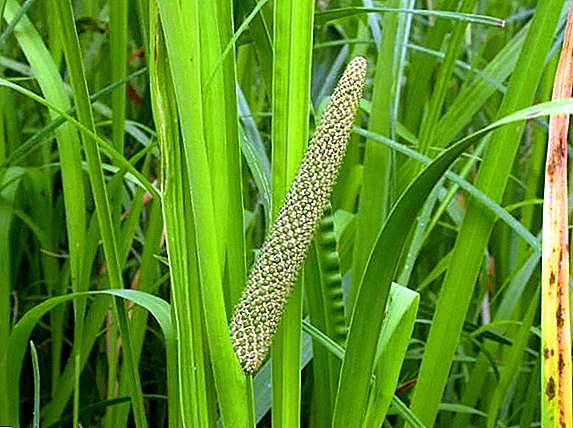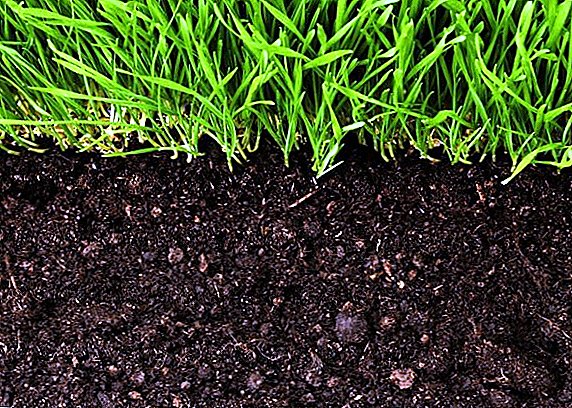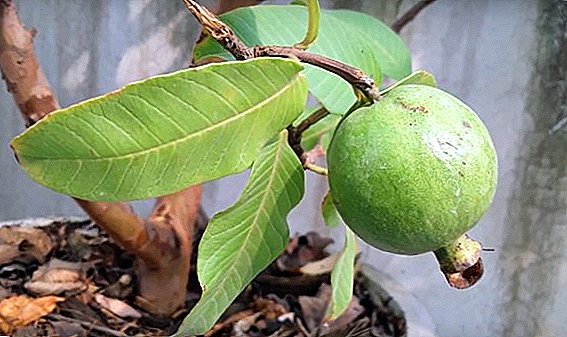 Guava (Psidium guajava) is a fruit tree, the fruits of which are eaten fresh and used to make juices. Guava is very sensitive to cold, grows only in the tropics, but is an ideal plant for growing in a room. For the summer, you can take out the potted guava tree on the porch, patio or patio, and in the fall to move it to a house or a winter garden.
Guava (Psidium guajava) is a fruit tree, the fruits of which are eaten fresh and used to make juices. Guava is very sensitive to cold, grows only in the tropics, but is an ideal plant for growing in a room. For the summer, you can take out the potted guava tree on the porch, patio or patio, and in the fall to move it to a house or a winter garden.
Let's consider what you need to know in order to properly plant a tropical guest and care for her at home.
Guava looks like: botanical description
Guava (Psidium guajava) - is a shrub evergreen tree up to 10 meters high, with a smooth reddish-brown bark. The plant has oppositely located oblong leathery leaves and fragrant white five-petalled flowers (large, about 4 cm in diameter) with bright white filiform stamens. Fruits are edible, yellow and round (sometimes pear-shaped), with a diameter of 3 to 10 cm. Sometimes there are varieties with red fruits (strawberry guava, or Psidium cattleianum).
Find out what is so remarkable about the fruits of guava.
Guava is grown for the fruit, which is technically a berry, but still perceived by the consumer as a fruit. The fruit has a thin, yellow, slightly acidic, edible layer under the skin, followed by yellow seeds (more than 3-5 mm long) in juicy pink or yellow flesh. For the manufacture of canned fruit and juices using a thin layer of fruit rich in vitamin C.
Did you know? In the ruins of Pompeii, archaeologists have discovered not only the well-preserved remains of dwellings, but also not much damaged clay pots with the remains of plants that were once grown in them. It turns out that container gardening was widespread in ancient times.
Distribution and habitat
The native land of guava is considered to be the tropics of South America and Mexico, but the plant has settled outside the natural range due to cultural cultivation. It is currently cultivated in southern Florida (USA), Bermuda, and throughout the West Indies from the Bahamas and Cuba to Trinidad and south to Brazil.
The first information about guava came from the Hawaiian Islands in the early 1800s. There it grows everywhere: on pastures, roadsides, and also in scrub forests at an altitude of 1200 meters above sea level.
Guava fruit trees in our latitudes do not grow, because they do not tolerate the cold weather characteristic of our country. These trees should be protected from cold winds even in the southern warm climate, where sometimes also lowering the temperature. 
Learn how to grow pomegranate, zizifus, kiwi, orange, lemon, five leaf gynostemma, banxia, cucumber tree, pineapple, laurel, annonu, rambutan, calamondin, anguria, banana, azimine, kivano, luffa.
Popular types of guava
Regular guava is well grown in a pot. If the gardener provides the plant with a warm, humid climate and good sunlight, the guava will bear fruit regularly.
There are several types of guava that are suitable for growing in containers:
- Tropical Guavas (Psidium guajava) - known for large and juicy fruits. Fragrant white flowers with long stamens appear on the tree throughout the year, gradually giving way to light green fruit with dark pink flesh inside. Ripe fruit is very fragrant. This variety is the most tender of all, it is more thermophilic than other varieties, and can grow up to 3-4 meters without cutting.
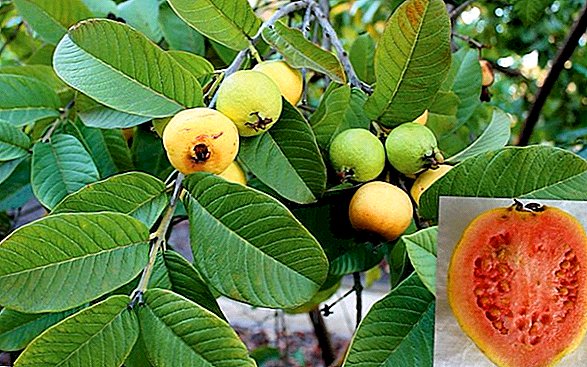
- Strawberry Guavas (Psidium cattleianum) - a weed plant in many tropical regions, Brazilian guava strawberry is perfect for container growing in countries with a cold climate, provided that the plant stays at temperatures not lower than + 10 ° C. Flowers of a tropical sissy are small, white and fragrant. The tree begins to bear fruit in August, with suitable temperature conditions, fruiting continues until winter. The fruits of this variety are round fruits with red skin and white flesh.
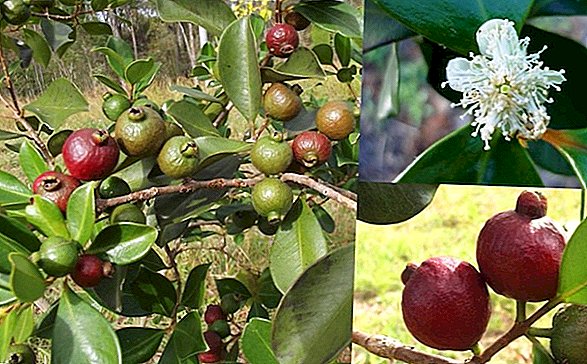
- Lemon Guava (Psidium lucidum) - also suitable for container cultivation. This plant is also small in the wild and grows very compact in a pot, its growth (without pruning and pinching) stops at a height of 1.50 m. The lucidum variety has white small flowers and fragrant fruits with yellow skin and a tart taste.
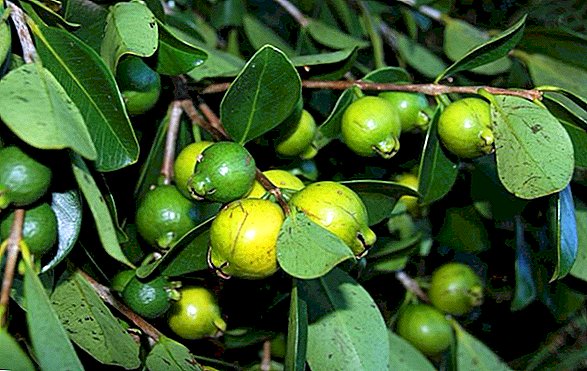
- Pineapple Guava (Feijoa Sellowiana) is the most frost-resistant variety and tolerates low temperatures down to -9 ° C. The natural height of these trees reaches 3-4 meters. This variety is also grown in soil and in containers.
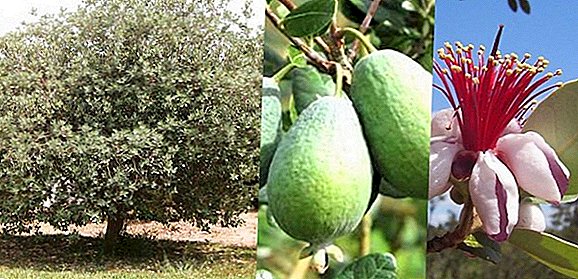 Pineapple guava, she feijoa
Pineapple guava, she feijoa
Did you know? Potted orchids behind their elegant look hide the real vampire character. They have no place in the bedroom, it is at night that they are most actively energized. But there, where passions boil, emotions spill out, they will bloom best. Orchids are good companions of people active, strong, with an excess of internal energy and explosive temperament.
Growing and caring for a plant with your own hands
In their natural habitat, guava trees, even undersized varieties, grow to 2.5–4.0 m. However, grown in a pot, it grows much shorter, as its root system is limited to the walls of the container.
Guava trees grown in containers can grow (and remain so) up to 1.2–1.5 meters in height, which makes plants ideal for indoor growing. To grow a beautiful guava, you need to provide it with good illumination, suitable temperature conditions, timely watering and pruning.
Find out how feijoa is useful, how to grow it in open ground and as a houseplant, how to make feijoa tincture and tincture.
Conditions of detention
- Landing Capacity Requirements - choose a large container, its width should be at least 45 cm, and the height of the pot should be at least 60 cm. The pot can be made of wood, plastic, non-oxidizable metal, clay ceramics or thick-walled porcelain. Most importantly, in every container suitable for planting guava, there should be drainage holes at the bottom to drain excess moisture. If you choose a container for planting without drainage holes in the bottom - the roots of the tree may rot in the future, which will certainly lead to the death of the plant.

- Drainage - at the bottom of the planting pot is placed in the drainage of pieces of foam, coarse thick branches (stacked crosswise) or expanded clay.
- A place - Guava likes to grow in a place well-lit by the rays of the sun, protected from the cold northern winds. This is a tropical plant that adapts very easily to a temperate climate. If the guava in a container is grown in a southern climate, you need to choose a place where it is sunny for 6 hours a day, the rest of the time the plant can be attached. In colder climatic zones, place the tree in a place that is fully illuminated by the sun, and then the plant will feel great.
- Formation load of fruits - whenever a guava blooms, it is better to remove the flowers, not allowing the fruit to tie. This is especially true of young and weak plants. If the gardener decided to receive fruits from his indoor tree, do not leave more than four fruits on one branch. The branch must be strong and at least 3 years old.
- Transfer - every 10-12 months, you need to increase the size of the planting capacity in which the tree grows. A new pot should be slightly larger than the previous one (literally 2-3 cm). You can not plant a guava immediately in a very large planting container. To transfer to a new container, the plant is carefully shaken out along with a lump of earth from an old pot and using the transfer method, install an earthen ball with a guava into a new pot.
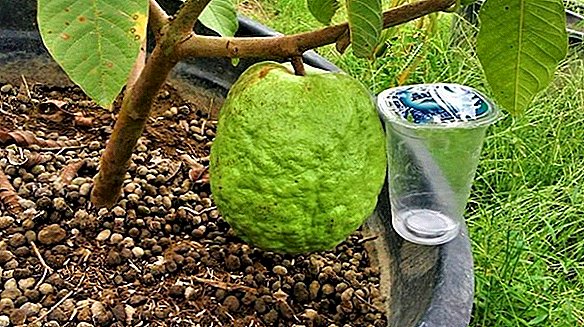
Did you know? A fat woman or a "money tree" is planted in pots to attract material wealth to the dwelling. This tree not only contributes to enrichment, but also treats severe depressions associated with financial difficulties.
Soil and fertilizer
Priming
- Guava is undemanding and grows well on various soils, but prefers well-drained soil with an acid-base balance (pH) from 5 to 7.
- Soil for planting - soil mixture should consist of equal shares of earth, sand and organic compost.
- To feed a guava tree, you need to purchase fertilizer for potted potted trees, which is sold in specialized garden stores.
- Flower growers are advised to refrain from guava fertilizer, starting in the fall and until the middle of winter.
- To feed young plants, you need to apply fertilizer once a month during the first year of life in small quantities.
- During the subsequent years of plant growth, the top dressing of plants is reduced to three to four times a year, but the single dose of applied fertilizer increases.

Learn about the properties of nitrogen, potash and phosphate fertilizers.
Watering and moisture
- Guava has shallow roots that quickly absorb water and nutrients, so it does not need frequent and deep watering.
- In summer, the plant should be watered abundantly two or three times a month (at the root and by sprinkling).
- In the winter months, the tree enters a state of rest, so watering at the root should be carried out rarely and moderately.
- When the top layer of soil becomes dry to a depth of 3-5 cm, it means that it is time to water the plant.
- The soil under a blooming or young guava (up to six months) must be kept in a slightly wet state. A uniformly moist soil during fruit loading helps the gardener to harvest juicy and sweet fruits.
Important! Guava trees are drought tolerant, in their native tropics, they are watered only during the rainy season. In between rains, trees calmly survive long periods of drought. However, for a container plant, it will be better if the root layer is slightly damp.

Relation to temperature
- The optimum temperature for this plant is between 20 ° C and 28 ° C. In winter, for young guava trees, the air temperature should not fall below -3 ° C. An adult tree (at least 3 years old) can withstand temperatures up to -6 ° C.
- These tropical trees feel great in warm climates, but are afraid of cold weather. Therefore, it is better to grow them indoors all year round or take them outdoors in spring, summer and autumn.
- In winter, the plants are brought into a well-heated room, the winter temperature is ideal for them from + 10 ° C to + 15 ° C. At temperatures below + 10 ° C, these tropical trees shed their leaf cover.
Reproduction and planting
Guava can be propagated in two ways: from green cuttings and from seeds.
Many gardeners prefer rooting guava cuttings in a mixture of perlite and vermiculite.
Growing from cuttings:
- Green cuttings are cut, on which there should be at least two internodes.
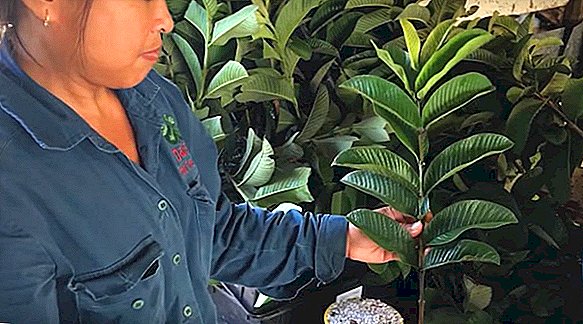
- After that, the cuttings are soaked for 12 hours in a solution of Kornevin or another root-forming drug.

- After soaking, each stalk sits in an individual planting container with the ground; when planting, it must be buried in the soil before the first internode.

- Soil in a pot with a green cutting planted moderately watered.
- A plastic bag is put on the pot (a mini-hothouse is obtained). This is done to create a greenhouse effect - it contributes to the rooting of the cutting.
- Every day for 3-5 minutes a plastic bag is removed from the pot to ventilate the seedling.
- Periodically, once every 7 or 10 days, planted cuttings are watered.
 If you plant a lot of planting material, you can plant several cuttings in one pot.
If you plant a lot of planting material, you can plant several cuttings in one pot. - After 25-30 days, the stalk will take root and grow (it will begin to grow the stem). Immediately after rooting, the plastic bag is removed from the container in which the young guava grows. Within six months, the soil under the young plant should be kept slightly moist. Further care will be no different from caring for an adult guava.
 For the proper formation of the trunk guava desirable to tie
For the proper formation of the trunk guava desirable to tie
Important! Guava tree, grown from seeds, begins to bear fruit only after 3-4 years. The tree obtained by breeding cuttings grows faster. The easiest and most convenient option is to buy a grafted guava tree in a special flower shop. Most grafted trees begin to bear fruit in the same year.
Seed propagation
Guava seeds older than one year partially lose their germination, so they must be stratified before planting in the soil. It should be noted that fresh guava seeds do not germinate well without stratification, this procedure is necessary so that the sprout can break through the hard outer shell of the seed. For the same purposes, in industrial cultivation, seeds with a dense shell are pre-treated with sulfuric acid; at home, the florist needs to boil or soak the seeds in hot water.
Stratification by seed boiling
- To soften the hard coating of the seed coat, you need to bring half a liter of water to a boil.
- Place the seeds in boiling water and boil for five minutes.
- After that, the fire turns off, and the water along with the seeds should be allowed to cool naturally.
- Seeds are planted in the ground immediately after they cool to room temperature.

Familiarize yourself with pre-seed treatment methods - scarification and stratification.
Stratification by hseed soaking
- Seeds are placed in a container, at the bottom of which lies a cloth napkin, warm water is added to the same place.
- Water should cover the seeds no more than the size of a single seed (3-5 mm).
- The container is covered with a lid and placed in a warm dark place for two weeks.
- Periodically you need to check how the seeds feel.
- If the seeds have swelled and absorbed water, you should add a little liquid, it is necessary that the seeds were wet and not dry.
- After two weeks, the seed coat softens enough to allow the inner sprout to pierce it, and they can be planted in the ground.

Find out what kind of lamps can be used to highlight indoor plants, how to save space and soil when planting seedlings, which requires picking.
Planting seeds
- Past stratification (soaking or boiling) the seeds are planted in a separate pot to a depth of one and a half to two centimeters, covered with soil, watered moderately.
- After that, a plastic bag is put on the pot to prevent evaporation of moisture from the soil.
- The pots of seeds are placed in a bright, warm place.
- When the first seedlings appear, you need to remove the plastic bag (the plant must learn to live in normal room conditions).
- Young guava is exposed on a well-lit window sill for further growth.

Important! Guava seeds germinate at temperatures from + 23 ° C to + 28 ° C, if the soil temperature drops below + 15 ° C, the seeds freeze and stop growing. The seeds of this plant germinate very slowly, they need from four to twelve weeks before the tiny shoots appear above the soil surface.
Repotting
Transfer to container
It is recommended to replant the plant once a year, at the end of winter or at the beginning of spring, in order to change the soil. This is the right time to increase the size of the pot by 3-5 cm, if the plant has outgrown its small pot and the walls of the old one do not allow the roots to grow.
If the gardener does not want the plant to grow, and intends to limit the further increase in the roots and the above-ground mass, then at the annual transplant, trim the root system by 1/3 of the total using a pruner. And changing the soil, plant a guava in the same pot. Guava root system
Guava root system
Transplantation in open ground
- A landing pit is dug out in a well-lit and sheltered place from cold winds and drafts.
- The landing pit should be 3-4 times larger than the container in which the tree grows.
- Humus or compost in the amount of 1/4 of the total volume of the recess in the soil is brought into the landing pit.
- Fertilizer with a spade mixed with the ground.
- The tree is shaken and carefully removed from the planting container.
- Earthen ball with the plant set exactly in the middle of the planting pit.
- The side gaps in the planting hole left unfilled with soil are filled to the top with soil, so that a small depression of 5-10 cm is obtained on the surface of the soil.
- A peg is driven into the ground next to the tree at a suitable height and a plant is tied to it. This supporting peg will be needed by the plant until it hardens in the ground and begins to grow. For the garter is taken soft natural rope (not synthetic and not wire).
- The tree is watered under the root in the dredge that has turned out in the ground. For irrigation of a meter tree, 5-6 l of water is enough; if the plant is above a meter, 10 l of water is poured at the root.
- Care should be taken to ensure that during the summer the soil under the young tree remains slightly damp. In the absence of rain watering is carried out weekly.

Important! . Gardener still need to remember that in the middle climate zone, tropical guava will not survive the winter. A resident of the tropics will survive only if a heated, well-lit greenhouse is built over a tree in the fall.
Pruning
All pruning operations are carried out using a small, sharp garden pruner with slightly rounded blades. Before the procedure, the pruning blades are wiped with alcohol. Если планируется обрезка ещё одного дерева, то лезвия секатора снова протираются обеззараживающей жидкостью.This is done in order not to transfer the disease from one plant to another.
Forming a young tree
The top of a young guava plant without side branches should be cut at a height of approximately 30-60 cm. This is done in order to cause lateral branching of the plant. During the first year, 3 or 4 well-distributed lateral branches should be selected and allowed to grow from 60 to 90 cm, after which they should pinch the growth point to cause further branching.
New branches, formed after pinching the main branch, also “pinch” after they reach a length of 40 to 60 cm. In the future, curves or unsuccessfully placed shoots should be removed.
Sanitary and anti-aging pruning
- With the help of trimming the desired height and shape of the plant is maintained, and too thickened crown is thinned out, preventing the penetration of sunlight and air. And also pruned cleaned dry and damaged branches and leaves.
- If the florist wants to rejuvenate his tree, then with the help of a secateur, old thick branches are cut. After some time, the plant restores the lost above-ground mass, increasing new stems and branches.
Pruning can be used to stimulate non-seasonal flowering of guava and fruit set. After pruning, trees begin to grow branches. Usually branches appear from the lateral buds on the tree trunk or at the ends of the lateral shoots. For a period of 2-3 weeks, the plant is left without watering. Pruning and temporary drought causes the tree to attend to offspring, which causes further flowering and fruit set.
Did you know? The Babylonian king Nebuchadnezzar was one of the first to “domesticate” the plants. He was the founder of the hanging gardens of Babylon. This idea was conceived and brought to life so that the king’s beloved wife would not yearn for the parental home.

Possible difficulties in growing
- Leaf fall - the plant does not like abrupt changes in location, as a result, the tree may lose (partially or completely) the leaves.
- Stretching and thinning of the crown - To get a beautifully shaped tree, you need to regularly nip the side and center points of growth.
- Fertilizers - for the winter it is advisable not to fertilize the plant, so as not to cause rapid growth. The tree needs to rest, because there is not enough light in the room in winter.
Pests, diseases and prevention
Guava insect pests:
- Caribbean fruit fly (Anastrepha suspensa) - the most formidable pest of guava, fruits infected with fly larvae become unsuitable for human consumption. Covering freshly tied fruit with covers of agrofibre or paper, almost completely protects the fruit from fruit fly infection.
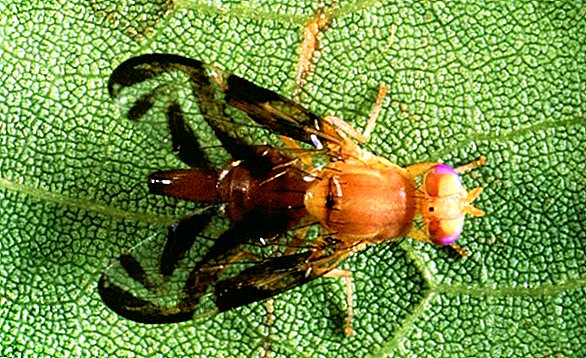
- Guava worm (Argyresthia eugeniella) - white larvae with black head. The larvae make tunnels in the fruit, after which they become unsuitable for food, and pests eat the leaves of the plant. To protect the crop from these insects, fruits are covered with paper bags (or spunbond covers) and biological plants are sprayed over the branches to scare off this pest.
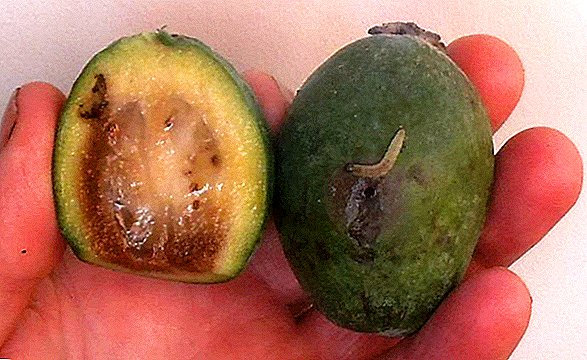
- Red thrips and whitefly - these two types of pests eat guava leaves, causing shrinkage and deformation of newly formed fruits.
 Leaves of guava affected by thrips During the summer and early fall of the plant, guava plants should be inspected; when insects are detected, the plant is treated with insecticides.
Leaves of guava affected by thrips During the summer and early fall of the plant, guava plants should be inspected; when insects are detected, the plant is treated with insecticides.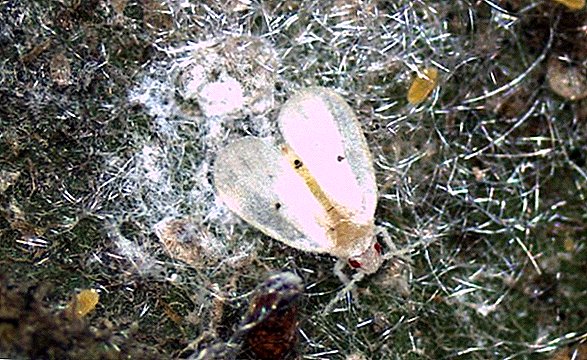
Learn how to fight common pests of houseplants - spider mites, thrips, whiteflies, nematodes, mealybugs, pseudoprotectors, scale insects, aphids.
Nematodes
Guava roots can be damaged by several types of nematodes. Nematodes are microscopic roundworms.
Symptoms of damage to the roots of nematodes:
- suspension or growth retardation;
- wilting and yellowing of leaves;
- shedding of branches and leaves;
- the death of the tree.
 Damage to guava roots by nematodes Before planting guava trees in a container, it is necessary to disinfect the soil for planting by heat treatment (in the oven) or by spilling boiling water. Also avoid the appearance of pests will help the soil mulching and moderate fertilization and irrigation.
Damage to guava roots by nematodes Before planting guava trees in a container, it is necessary to disinfect the soil for planting by heat treatment (in the oven) or by spilling boiling water. Also avoid the appearance of pests will help the soil mulching and moderate fertilization and irrigation.Did you know? Aloe or agave is a true home pharmacy. With its healing properties, the plant still cleans the energy of the house. To stop worrying, it is enough to sit next to this flower. It protects the owners from evil thoughts and troubles of others.Fungal diseases
- Anthracnose (Colletotrichum gloeosporioides) is a fungal disease that manifests itself on fruits, leaves and young stems and causes dying and leaf fall. On young leaves, anthracnose looks like big dead brown or black spots. Spots can be pink in color (developing fungal spores).
 Anthracnose on fruits - round spots from brown to black, increasing with time, pink color may also be present on them.
Anthracnose on fruits - round spots from brown to black, increasing with time, pink color may also be present on them.
- Various leaf spots can be caused by the mushrooms Cercospora and Pseudocercospora. Symptoms of diseases are, as a rule, dark smoky spots on the lower surface of leaves.

Learn how to treat and prevent powdery mildew, rust, chlorosis, monopsy, monlysis.
Treatment and prevention of fungal diseases
Guava thickening of the crown contributes to the fungal disease of guava. The thinning pruning of branches and crown will help the already diseased plant, it will open access to light and air, which will prevent the development of fungal spores. As a preventive measure against fungal diseases, wood treatment with copper-containing preparations is used (once or twice a season).
Learn how to use copper sulfate and Bordeaux mixture.
A little knowledge, a little patience and care - and a green, lively note of a tropical plant will be added to your home comfort. You just need to remember that although certain types of guava withstand a significant drop in temperature, they still remain a tender plant that needs protection from extreme frost. Successful cultivation!
Video: how to grow guava
How to grow a guava at home: reviews

I read in various forums that even large specimens in the winter for the leaves are thrown, and the points of growth are dropped just like in yours. In the spring, with a well-established temperature, people plant them in the Exhaust Gas or take them out to the fresh air in pots, drop them in, plants grow well and plant buds, and with the coming of August they bloom and set fruits.
But it is only in the autumn, after the drift into the apartments, the problems begin - dumping of leaves, ovaries and drying of growth points. This happens not only with Psidiums, it happens with citrus too. The change in the intensity of insolation, humidity, air convection and the temperature regime of the soil is a significant change in the conditions of detention.
I still think that in winter, plants that do not need lowering temperatures for full development and planting fruit buds need a lot of light - high-quality lighting and not a strong temperature difference at night and during the day, well, and high humidity.
That's just in the big boxes, they can and winterize, and then - in the spring, gradually adapt to the usual content. So that the leaves do not burn in the spring sun, temporarily apply a curtain of plastic film (enough for a couple of weeks).
"But, it is necessary to take into account the fact that - parasitic red alga damages the leaves, especially in conditions of high humidity. The fungal infection of trees leads to their inevitable death. To prevent this, you need to treat them with fungicides in time. Copper and other fungicides are very effective and mulching. " (with)
Of course, not all Psidiums are so capricious, there are Spartans. For example - Psidium Cattley var. coastal (Psidium cattleianum var. littorale), in everyday life referred to as "strawberry guayavy" - is a completely different species from the genus Psidium, family Myrtle. The psidium cattley and psidium guava are easily distinguished by leaves. In Kettley, they are leathery and shiny, and in guava, they are not shiny, matte. In the care of Psidium guayava more thermophilic.






 Pineapple guava, she feijoa
Pineapple guava, she feijoa




 If you plant a lot of planting material, you can plant several cuttings in one pot.
If you plant a lot of planting material, you can plant several cuttings in one pot. For the proper formation of the trunk guava desirable to tie
For the proper formation of the trunk guava desirable to tie

 Leaves of guava affected by thrips During the summer and early fall of the plant, guava plants should be inspected; when insects are detected, the plant is treated with insecticides.
Leaves of guava affected by thrips During the summer and early fall of the plant, guava plants should be inspected; when insects are detected, the plant is treated with insecticides.
 Anthracnose on fruits - round spots from brown to black, increasing with time, pink color may also be present on them.
Anthracnose on fruits - round spots from brown to black, increasing with time, pink color may also be present on them.


